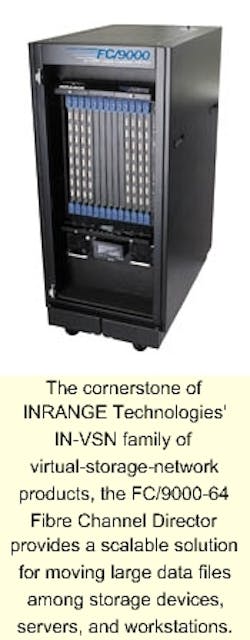Director tackles burgeoning storage-area-network requirements
BY MEGHAN FULLER
SYSTEMSAs in other forms of networking, interest in storage area networks (SANs) has grown with the advent of the Internet, e-business, and the general demand for round-the-clock availability of data that could be housed virtually anywhere. Initially, users put their computers and peripheral devices on LANs and used the LAN to transfer huge data files from one destination to another. Over time, cost considerations, the scarcity of bandwidth, and slow response time forced industry experts to develop SANs as an alternative to the LAN method. The two networks run concurrently; the LAN manages the user traffic while the SAN or back-end network manages the traffic flow between the computers themselves. The SAN permits users to offload their LANs, allows their systems to communicate at high speeds, and enables resource sharing, data sharing, and automated backup and recovery.
The average SAN used to have two or three computers and a few storage devices, but users have grown increasingly greedy. Asserts Charles Foley, executive vice president and chief technical officer of INRANGE Technologies Corp. (Mount Laurel, NJ), "The industry has been saying, 'We need our storage area networks to get bigger and bigger and bigger,' which means you need a bigger and bigger and bigger traffic cop [to manage those networks]." INRANGE has developed a traffic cop it believes will meet the industry's demand: the FC/9000-64 Fibre Channel Director, the cornerstone of the company's IN-VSN family of virtual storage networking solutions.
Targeting the high end of the storage market, the FC/9000-64 scales up to 64 self-configuring, 1.062-Gbit/sec ports, each of which may be configured as arbitrated loop, transitive loop, segmented loop, point-to-point, or switch-to-switch mode. It provides full-duplex, gigabit-per-second bandwidth and support for Class 2 and 3 service levels.
According to Foley, the concept of the storage area network is not new. As early as 1991, the IBM mainframe world introduced a technology called Escon (Enterprise Storage Connec tivity), which was the mainframe standard and used fiber-optic cables to hook multiple CPUs to multiple storage devices. Because this technology was mainframe, proprietary, and legacy, however, it did not catch on, but INRANGE kept it in mind when developing the FC/9000-64.
"We took a lot of our expertise from the Escon world, where we make 256-port directors, and the data-communications world, where we make 24,000-port switches, and said, 'Let's apply some of that scalability and mission-critical design requirements to the SAN world,'" explains Foley.
INRANGE's expertise included switches and directors but came up short on the subject of Fibre Channel, a topology that enables concurrent communications among computers, servers, storage devices, and other peripherals. Fibre Channel is a very-high-speed network connection-100 Mbytes/sec-and usually runs over fiber-optic cables. The company decided against manufacturing its own Fibre Channel ASICs and instead partnered with QLogic Corp. (Aliso Viejo, CA), formerly Ancor Communications Inc.
The FC/9000-64 is itself just one part of a greater solution that INRANGE calls its IN-VSN (pronounced "in vision") family, which is designed to connect storage resources across both extended distances and mixed-platform environments.
The product addresses a disconnect between networking reality and users' ideal perceptions. Explains Foley, "If you drew three concentric circles, like a bull's-eye, right in the middle is the data center, that is where directors lie. The second circle is where you have departmental systems, campus environments-the metro environment. The third circle is what we call a virtual storage network, which is long-distance geography-maybe across town, maybe across the country, maybe across the world." Users only want one enterprise storage network, however; they want one logical entity, and therein lies the problem that INRANGE believes it has solved with the IN-VSN family.
The company developed the FC/9000-64 for the core of the circle, to sit in the data center and manage the SAN, but they also have a technology for the second circle-8- and 16-port switches for small, distributed, and departmental environments. And they tie both circles together using DWDM technology. INRANGE partnered with Sorrento Networks Inc. (San Diego) for the INRANGE Sorrento GigaMux metro DWDM solution, a carrier-class platform that increases the capacity of new and existing fiber-optic networks by transporting up to 32 duplex channels of information over a single fiber strand.
The company also has a solution for the virtual storage network, the third concentric circle. "Say [you're on the East Coast and] you have operations in San Francisco and Los Angeles; you can't use DWDM. You can't run cable that long," says Foley. "We have a technology called Channel Extension, which actually makes the system think that its peripheral devices are right next door, but they could be hundreds or thousands of kilometers away." The three technologies combined-directors, switches, and the WDM and Channel Extension technology to conquer distance-have convinced INRANGE that its IN-VSN solution is unchallenged in the SAN market. While Foley admits there are several point competitors, the IN-VSN line does not have a direct competitor.
In fact, Foley expects the biggest hurdle for the FC/9000-64 will be keeping up with demand. "Director sales are growing at more than 200% this year over last year, and next year over this year," he says. "So we are going to have an operational challenge that asks, 'Can you produce as much as the market can eat?'" The company has already announced plans to release a Fibre Channel Director scalable to 128 ports by 2001.
The network storage market is indeed burgeoning, according to a report, "The Two Faces of Network Storage: NAS & SAN Market Analysis," from Cahners In-Stat Group (Scottsdale, AZ). End-use sales will reach over $10 billion by 2004, a compound annual growth rate of more than 50%. Sales this year alone are projected to reach almost $2 billion.

